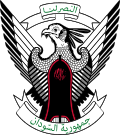 The National Revolutionary Command Council. | |
| Formation | 25 May 1969 |
|---|---|
| Dissolved | 12 October 1971 |
| Type | Acting Presidency Collective leadership |
| Legal status | Dissolved after a referendum. Nimeiry became President constitutionally. |
| Headquarters | Khartum |
Region served | |
Membership | 10 (until November 1970) 7 (after November 1970) |
Chairman | Maj. Gen. Jaafar Nimeiry |
Deputy Chairman | Babiker Awadalla (until July 1970) |
| Affiliations | Presidency of Sudan Sudanese Army Parliament |
| History of Sudan | ||||||||||||||||||
|---|---|---|---|---|---|---|---|---|---|---|---|---|---|---|---|---|---|---|
 | ||||||||||||||||||
| Before 1956 | ||||||||||||||||||
|
||||||||||||||||||
| Since 1955 | ||||||||||||||||||
|
||||||||||||||||||
| By region | ||||||||||||||||||
| By topic | ||||||||||||||||||
| Timeline | ||||||||||||||||||
The Revolutionary Command Council was the body that ruled Sudan after the coup d'état in May 1969. It was disbanded in October 1971.
Initially Babiker Awadalla, a lawyer, served as Premier, but was then moved by Maj-Gen Gaafar Nimeiry to become deputy chair of the council on 26 November 1969.[1] Joseph Garang, a southerner, was also on the council in its initial days.
- ^ OBallance 1977, p. 104-5.